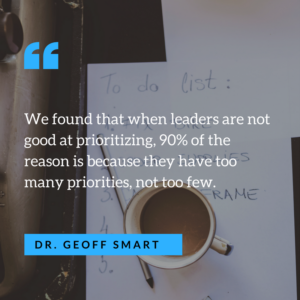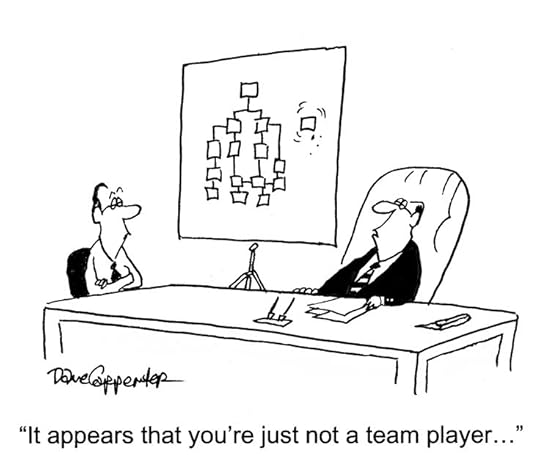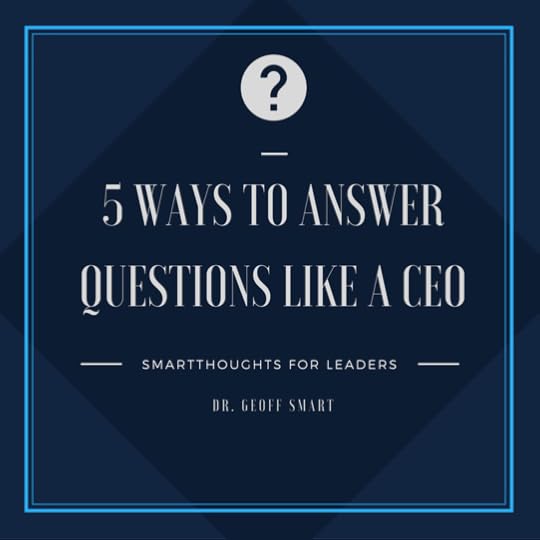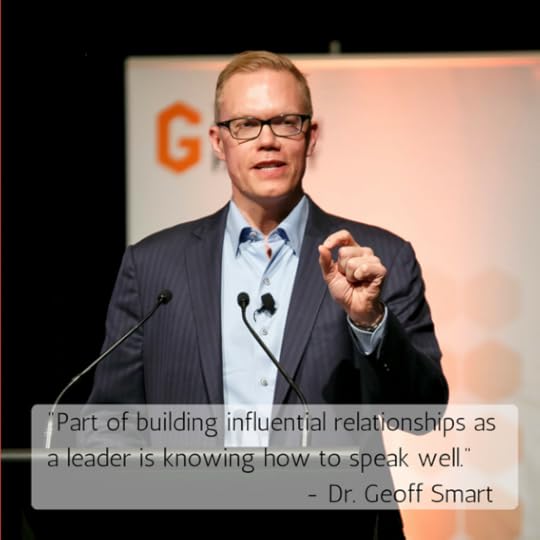Geoff Smart's Blog, page 5
September 27, 2016
Set the Right Priorities with this Formula You Learned in Econ101

Most leaders struggle to prioritize.
In the research we did for Power Score, which included 9 million data points on successful and unsuccessful careers, we discovered that only 24% of leaders are rated as good at prioritizing.
No wonder so many employees are confused!
No wonder so much money gets wasted on things that don't matter!
No wonder people feel so stressed out—and feel like they are juggling too many balls at once.
Here is another important finding. So the trick to becoming good at prioritizing is to figure out how to narrow down the number of priorities to the two or three that matter most. [...]
You're reading Set the Right Priorities with this Formula You Learned in Econ101, originally posted on SMARTthoughts for Leaders and copyrighted by Dr. Geoff Smart.
September 21, 2016
What if the Secret to Job Happiness is Who You Work With?
The title should say "with whom one works."
But "who you work with" is how people actually talk. And I want this article to be easy and useful to read.
At ghSMART, we use a lot of data in our consulting work. And to discover valuable insights for our books, we analyze large datasets of successful and unsuccessful careers. These datasets take decades of work, and tens of millions of dollars, to collect and analyze.
So what I'm about to do is a departure from our normal way of giving advice. It is somewhat of a guilty pleasure to not have the data, nor the answer.
But we have an extremely interesting question for you to ponder, as you think about your own job happiness. [...]
You're reading What if the Secret to Job Happiness is Who You Work With?, originally posted on SMARTthoughts for Leaders and copyrighted by Dr. Geoff Smart.
September 15, 2016
3 Ways to Get Your Life Back
I looked at the executive's desk and noticed something weird.
A small framed picture sat alone on her desk with a sign in it that said "Eat Lunch."
"Why do you have a sign that says 'Eat Lunch'?" I asked.
"Because I never eat lunch," she replied.
"Why not?" I asked.
"Too busy. My job is all-consuming. If I am ever able to eat lunch, I'll know that I got my life back. In the meantime, I just eat one of these snack bars between meetings," she said as she showed me a pathetic half-eaten tan bar in a wrapper. She shrugged with a gesture that said, "What else am I supposed to do?"
This scene horrified me. When this happened, I was just starting out in my career, two decades ago. I felt sad that a perfectly capable business leader seemed so powerless in the fight to reclaim her life back from her job.
Work is not supposed to be like that.
It is not supposed to suck the life out of you.
I have, as a hobby, made a point of collecting tactics that successful leaders use to seize their lives back from their careers.
You're reading 3 Ways to Get Your Life Back, originally posted on SMARTthoughts for Leaders and copyrighted by Dr. Geoff Smart.
September 8, 2016
How to Hire Team Players
By Geoff Smart and Pat Lencioni
September 8, 2016
Geoff: Pat, your new book The Ideal Team Player is crushing. Congrats on its success!
Pat: Thank you. I’m grateful that so many managers and leaders find it helpful.
Geoff: As a fellow business book author, I’m impressed that a fable format works so well with a business audience. Why do you think the fable format has been so successful for you?
Pat: When I wrote my first book, I wanted to write something that was a quick read. I had been an amateur screen writer earlier in my career, and I thought a fable format would be an interesting way to convey a message. And, most of my stories are rooted in reality. Otherwise, I don’t think people would like them.
Geoff: Your new book seems to have touched a nerve.
Pat: Why do you think that is?
Geoff:
It’s the searing pain that most leaders feel when they hire somebody who turns out to not be a team player.
One of my clients called us after hiring a C-suite leader who turned out to be anything but a team player. The new executive turned out to be egotistical, careless, and EQ-deprived. Get this. This person also kept people waiting as long as two hours for meetings!
Pat: Kept people waiting for two hours? I’ve known an executive or two like that.
Geoff: Yes, he expected teammates to wait outside his office for two hours until he eventually got around to meeting with them. He managed from his desk at his newly-renovated fancy office. He was completely tuned out to the needs and wishes of his teammates—both peers and subordinates. Customers were mad. Good people left. The business’s profitability tanked. It was a hiring disaster which cost our client millions.
Pat:
The cost of hiring a non-team player is lost productivity, downward pressure on the team’s results-and the misery of working with the person.
Everyone knows it’s desirable to hire team players. But the concept of a “team player” has been so intangible. One of my motivations for writing the book is to help people understand that there are three specific virtues that every true team player must possess.
Geoff: What are those three virtues you say are so important?
Pat: The ideal team player is humble, hungry, and smart. If a candidate is strong in those three areas, chances are they will turn out to be a great team player.
Geoff: I like those criteria. Virtues indeed. And the criteria in your Five Dysfunctions book are also important to add to the list–trust, conflict, commitment, accountability, and results. Combine all of those criteria together with a clear statement of mission and measurable goals that you want a person to accomplish in the job, and you have what we call a scorecard in our Who book.
Pat: Yes, half the challenge of hiring team players is to know what you are looking for.
Geoff: Right, and the other half the challenge is to actually find it.
Pat: It’s hard. It’s not like people write “I’m a lousy team player” on their resume or LinkedIn profile.
Geoff: That reminds me of a story Jay Jordan told me. Jay is a very successful CEO. He had to fire someone shortly after the person started. Jay sat the person down and said, “I hired your resume. But unfortunately, what I got … was you.”
Pat: Yes, resumes and online research have their limitations, and can be misleading. In contrast, a well-conducted interview is an important tool for finding out the truth about someone. I offer some hints and interview questions in my book.
Geoff: I saw those. They are good questions for getting at the truth. When I did my Ph.D. in Psychology two decades ago, specializing in pre-employment interviewing, I learned that all interview methods are not created equal. Poorly-conducted interviews yield unreliable results, and lead to hiring mistakes.
Pat: Poorly-conducted interviews—like where the interviewer does all the talking? Or asking candidates questions that are not really relevant to the culture of the company or to the job itself?
Geoff: Yes, yes. And other bad interview methods are asking candidates hypothetical questions — how would you resolve a conflict with a team member? It’s too easy to B.S. those answers. There is no way to verify the answers. No, it’s much better to ask candidates a ton of questions about their actual jobs, to learn clues about how they actually performed on their teams across their career. And then if you call 5 to 7 teammates as references to verify the candidate’s claims, you are going to hit 90% hiring success. But just asking candidates vague or hypothetical questions and failing to do reference interviews yields that low 50% hiring success rate. And bad hiring means your team will not run at full power.
Pat: Let’s summarize for our readers. It sounds like we are saying it’s better to hire team players than not.
Geoff: For sure.
Pat: Ideal team players practice the virtues of being humble, hungry, and smart.
Geoff: So put those, and any other criteria you want to measure, on the scorecard you use to rate candidates.
Pat: And we are in agreement that lousy interview methods won’t give you clues about how well someone will perform on your team. But a thorough interview method will give our readers a 90% chance of success in hiring a team player.
Geoff: Yes. Here’s to practicing good hiring, and having more team players!
Leaders bet their career success every time they hire someone.
I’m hopeful our readers find our suggestions useful in improving their bets!
—Dr. Geoff Smart is Chairman & Founder of ghSMART, a leadership consulting firm that exists to help leaders amplify their positive impact on the world. He is known for being the world expert on the topic of hiring. Click for his downloadable free tools, and events.
—Pat Lencioni is President of The Table Group, a management consulting firm specializing in executive team development. He is regarded as the top thought leader and speaker in the world on the topic of teams. Click for his downloadable free tools, and website.


The post How to Hire Team Players appeared first on Dr. Geoff Smart.
September 2, 2016
5 Practical Ways to Learn Something New in Business
 I have five practical ways to learn something new in business, based on having interviewed and advised over a thousand business leaders. Some of those leaders went from being dirt poor to becoming self-made billionaires.
I have five practical ways to learn something new in business, based on having interviewed and advised over a thousand business leaders. Some of those leaders went from being dirt poor to becoming self-made billionaires.
How do they do it?
Is it just that they are so much smarter, or harder working than the rest of us? Or maybe it was just good luck? No.
I think many super successful leaders get there by learning better than the rest of us.
I’ve observed some best practices over the years, and I’ve also personally used each of these tactics to learn something new. I founded ghSMART in my graduate school dorm room in 1995, knowing nothing about anything. I was passionate about building a special kind of leadership consulting firm—to create a new version of a Bain or McKinsey, but which advised leaders on “who” not “what” matters, and which offered exceptionally talented people a career platform based on freedom and flexibility. When I earned my Ph.D. and became “Dr. Smart” at age 25, I felt like an impostor—a Doogie Howser-looking child man. It would be many years before client prospects would stop asking me how old I was in every first meeting. I knew I had a lot to learn!
Today, our firm serves as leadership advisors to hundreds of leaders around the world, with nearly a hundred Smarties located in offices in a dozen cities in the U.S., Europe, and Asia.
How is that possible? Starting out as a young and clueless founder, I practiced these five learning techniques throughout the years on topics as diverse as industrial psychology, strategy, general management, private equity finance, government, predictive analytics, and digital marketing. And without too much cost, and without suffering too much hassle, I enjoyed adding confidence and expertise in a few new areas, which have proven useful in navigating our growth as a firm.
Here are five practical ways to learn something new in business.
READ 10 BOOKS.
It’s easy. Go to amazon. Type in the topic you want to master, and read the top-selling 10 books. Pay attention to the words and concepts that seem to matter the most. Total cost = $200.
GO TO THE BEST WORKSHOP ON THE TOPIC.
When I was learning about the topic of predictive analytics, I bought the book Predictive Analytics by Eric Seigel. I learned that the author hosted a huge conference on this topic, with the fitting name “Predictive Analytics,” so I went to it. When I wanted to learn more about structuring private equity transactions, I went to a workshop at Harvard Business School called “Structuring Private Equity Transactions.” Total cost for workshops = $1,000-$15,000. Oh, that reminds me. If you wanted to master the #1 topic in business — hiring talented teams — you might consider coming to the one public workshop I’m doing this decade. It’s in Denver this October 21. Click here to register for SMARTfest 2016.
INTERVIEW 10-100 EXPERTS FOR ADVICE.
A year ago, I decided I wanted to learn more about digital marketing. Many of our clients were struggling with the increasing digitization of demand creation. And I wondered how this trend might impact our own business in the future. Rather than interview 10 experts, I made a target list and used referrals to interview over 100 experts on this topic. People are happy to have a 30-minute discussion about their favorite subject, to help you learn and get oriented. I talked with venture investors who own digital marketing companies, coders at MIT’s Media Lab, a “Chief Digital Officer” (I didn’t know those existed), etc. You know you are getting your hands around a topic when you start to hear the same buzzwords and pieces of advice. Total out of pocket cost = $0 if you do it by phone, just the cost of your time.
HIRE SOMEONE AS MENTOR OR PARTNER.
You probably know a topic that an expert in another field would love to learn. Consider doing a “mentor swap” or “mentor barter” where you agree exchange advice and pick each other’s brain a couple times a year. I helped a tech entrepreneur on her first key hires in exchange for learning about digital product development, A/B testing, and crowd-sourced AI-driven predictive models. I learned a lot about government by advising three governors on their hiring practices. The only thing better than having an expert mentor is to hire an expert full time. That way an expertise gap can be filled by a rock star and you can also learn from them. For example, Randy Street was (and is) way better than I am at converting vision and strategy into a scalable organization that lives its values and achieves goals in client satisfaction and team retention. As Managing Partner of ghSMART for 9 years, Randy has not only done a great job, but he has taught our team a lot about his areas of expertise. Total cost = $0 for mentor bartering, lots more to hire an expert full time.
LEAD A PROJECT.
You have heard the expression “The best way to learn something is to teach it.” I’ve witnessed many clients and colleagues volunteer to run a project in an area of interest. In many cases, they were an expert when they started the project, but immersing themselves in the topic and working towards delivering results in that area boosted their expertise significantly. A year ago, my EA Jessica expressed an interest in social media and event management. To her surprise, and I hope delight, I gave her the sole responsibility of marketing and managing a public workshop event I’m doing this fall. And in case you missed the plug earlier, here is where you can sign up for it– SMARTfest 2016.
I have witnessed many leaders stall out in their careers. Most of the time it’s because they get set in their ways and they stop learning. If you want to keep thriving and adapting and innovating in your career, for the good of your career success and the success of your organization, please consider following these five tactics for learning something new. And if you think these tactics are useful, please download our other free leadership tools at SMARTtools for Leaders™.
The post 5 Practical Ways to Learn Something New in Business appeared first on Dr. Geoff Smart.
August 23, 2016
3 Ways to Run Meetings Like a CEO
Most meetings are a waste of time.
That’s because most managers don’t know how to run meetings like a CEO.
An important part of building great relationships, and leading talented teams, is to run meetings well. I’ve witnessed a wide range in meeting management skill—seeing ordinary leaders run meetings vs. learning how the most successful leaders do it. I’ve had the privilege of participating in meetings with over 20 self-made billionaire entrepreneurs and over 20 CEOs of Fortune 500 companies. And my ghSMART colleagues are really talented; I’ve learned a lot from them as well. So that is where my advice is coming from.
Do you want to know 3 ways to run meetings like a CEO?
ALWAYS REQUEST AN AGENDA.
I remember being invited to a business lunch early in my career, by a mutual acquaintance.
“I wonder what he wants to talk with me about,” I wondered naively.
A middle-aged man with a shiny pocket square in his blazer and a mouth full of smiling white teeth sat down across from me. After 3 minutes of required small talk, he revealed his agenda.
He said, “I work in risk.” “Oh,” I gulped. “Yes,” he continued, now summoning an earnest facial expression, “Does your firm, and family, have sufficient insurance coverage?” The rest of that meeting was so boring that I wanted to choke myself, as the insurance salesperson failed to close me on a new policy. I learned my lesson the hard way; that meeting was a waste of time for him and for me.
Now I only accept meeting invitations if there is an agenda. The first benefit of getting an agenda is you can decline a meeting if the topic or purpose is not of interest. Save time.
The second benefit of having an agenda is you can prepare, which makes the meeting more valuable for all parties. I remember when a client asked for a meeting to “just catch up.” I care about our clients’ time. So I wrote back, “So that I can prepare for our meeting, and make sure it’s valuable to you, what are some questions that you would like to discuss?” I had initially thought that the client wanted to go over the results of a recent project. But the questions that he sent me which he wanted to discuss had nothing to do with the project, and had everything to do with how he was managing his board. So having this agenda in advance of the meeting allowed me to look up the biographies of who was on his board, to anticipate what issues he might be facing, and to come into the meeting ready to dig into a discussion about how our client could manage his board more effectively.
The third benefit of having an agenda is that it makes you look competent! I frequently print off a brief 3-question agenda, on my ghSMART letterhead, and give it to the other people at the beginning of a meeting. “It sounds like these are the most important 3 questions on your mind,” I say. This gesture of respect and professionalism is often met with a glance of “Well, you have your ducks in a row!” from the other people in the meeting. And it helps the other people stay on task during the meeting, so the conversation doesn’t become unfocused.
ASK QUESTIONS, DON’T TALK MUCH.
This piece of advance is counter-intuitive. Aren’t CEOs supposed to tell their followers what to do in meetings? No. The great CEOs don’t!
The best CEOs I’ve witnessed ask broad strategic questions like “I wonder what is making our UK expansion harder than we anticipated?” They ask reflective questions to clarify priorities like, “So the three things you are saying we should do are 1) set up the banking relationships, 2) get 3 conference keynotes scheduled for Q1, and 3) hire Audra Winter as GM. Yes?” The final type of questions CEOs ask in meetings are accountability-related like “Who is going to do each of those things, by when?”
DISCUSS, DEBATE, and DECIDE.
At our firm, we call this “3D.” This simple format for problem solving makes meetings so much more useful. Once some background discussion of a topic is finished, CEOs say things like “Let’s debate what we should do about this. Who has some ideas?” Once a clear solution emerges, CEOs say, “It sounds like we are in agreement that Martin should be the one to pull together the new store-level metrics for each of our monthly meetings. Martin, are you willing to do this please?” That’s a decision. Meetings that have outcomes where people decide to do things are productive. Meetings where people “just talk” are not nearly as productive.
If you think these tactics are useful, please download our free leadership tools SMARTtools for Leaders™.
And if you want to watch me run a meeting, register for SMARTfest on October 21, 2016 in Denver. Master the #1 skill in business – hiring and talented teams and running them at full power.
The post 3 Ways to Run Meetings Like a CEO appeared first on Dr. Geoff Smart.
August 16, 2016
Five Ways to Answer Questions Like a CEO
 There are 5 bad ways to answer questions.
There are 5 bad ways to answer questions.
Avoid these pitfalls to get hired to your dream job or to lead your team successfully.
I have had the privilege of posing questions to over 1,000 business leaders for jobs and for our books. So I’ve been on the receiving end of many great answers from some of the most respected CEOs on the planet. And I’ve also heard answers from less-skilled managers.
Recently, I witnessed a horrendously bad answer to a simple question. A middle manager was asked a question like, “Does John Thomas work at Google?” We all would have appreciated a “yes” or “no” answer. But the person decided to take us on a 5-minute journey back in time, full of detours and tangents that had no relevance to the question at hand. We were made to sit and wait for the answer, which would be revealed at the end of this free-associative ramble.
Here are five ways to answer questions like a CEO.
Answer a yes or no question with a “yes” or “no” before you provide details.
Does John Thomas work at Google?
Bad answer: “John Thomas? Oh I knew him back at University of Michigan. He and I were in the same engineering lab. This one time…”
Great answer: “Yes. John Thomas works at Google now. We went to college together and we are Facebook friends.”
Answer a number question with a number answer before you provide details.
How much did your sales decline during the last recession in ’08?
Bad answer: “The Great Recession was a really hard time for us. It felt like we were running a marathon in quicksand. No matter what we did, it felt like customers just stopped buying…”
Great answer: “20%. Our sales declined by 20%. Fortunately, the compensation of our team was largely variable, so we all just made a bit less income during that period, and so we were able to avoid having any lay-offs.”
Say what was your goal, what you observed, what you did, and what were the results.
What happened in that job?
Bad answer: “Well, it was the South. I was not used to the South. Wow were the summers humid. And the mosquitos? Are you kidding me? Big as birds…”
Great answer: “My mission was to set up a new food bank in Atlanta. The goal was to recruit 20 restaurant partners, hire the first 5 employees, and to be serving 100 meals a day within three months. What I observed was that things moved a little more slowly than what I was used to. It was taking too long to get the restaurants to sign on. So I had to get creative. The service manager and I came up with a new concept. We hired a video crew, interviewed restaurant managers and customers, and gave free social media advertising to the restaurants if they signed up with us. It cost less than $5,000, which was approved by HQ. And this approach allowed us to achieved our goals a month earlier than planned! My bosses were thrilled and they later asked me to roll out the concept to the 10 other offices in the region.”
Answer from the other person’s point of view.
Why do you want me to invest in your ice cream stores?
Bad answer: “Because we need the capital to grow. And we need a way for some of our cousins to cash out of the business. This store has been in our family for 50 years.”
Great answer: “Because 10% return on invested capital is what you say you want. And that is what we have delivered reliably on a per-store basis for over 50 years.”
Share just enough information to prove your point, but not more.
Why should we buy from your company?
Bad answer: “I could give you a million reasons to buy from our company. For starters, here is our 150-page brochure. And here is a 25-page PowerPoint slide deck in 8-point font. Now I want to tell you about a dozen customer cases about some companies that are nothing like you. After that, I’m going to give you some more random anecdotes—whatever comes to mind!”
Great answer: “I think you should buy from us for three reasons: 1) Gartner Group did a survey of our industry and rated us #1 in the three areas that are most important to you—ease of implementation, security, and customizability for multiple languages. 2) We know this space better than anybody. Our team published the #1 book on this topic, on both sales and review ratings on amazon. And 3) we offer a 100% money-back guarantee, so the burden of risk is on me, not you. 97% of our clients rate their satisfaction very high, and chances are, you will too.”
If you found these tactics useful, you will like our other free tools for leadership success. Download SMARTtools for Leaders™.
Or if you want something a little more engaging, come participate in our upcoming workshop and master the #1 skill in business – hiring and leading talented teams. Click to register for SMARTfest 2016.
The post Five Ways to Answer
Questions Like a CEO appeared first on Dr. Geoff Smart.
August 3, 2016
Ten Smart Public Speaking Tactics You’ve Never Tried
We all place a high value on public speaking. Don’t we?
If a CEO gives an electrifying product launch speech, their stock price jumps up. If a politician gives a boring speech, we may not vote for them. If a colleague communicates well, their influence in your company grows.
Part of building influential relationships as a leader is knowing how to speak well. I’ve discovered a set of tactics which will make you more powerful during meetings, keynote speeches, and media interviews.
If you are a leader who wants to make an impact, please consider using these 10 smart tactics for public speaking you’ve never tried.
Where did we get these tactics?
Some came from trial and error. I’ve always been an active public speaker—debate team in high school, public speaking tournaments in college. And as a business leader and author I have had the privilege of giving hundreds of talks to small and large audiences all over the world for 20 years.
Also, my colleagues and I have worked with two amazing public speaking coaches. Steve Crews trained Fortune 500 CEOs, and was full of tough love. He once told me I should buy dark glasses. Why? Because my pale complexion and blonde hair gave me a “featureless moon face” which was not exciting to look at. (Hence the dark glasses I wear for most speeches today).
Steve’s most valuable public speaking advice was to urge leaders to think about “What do I want the audience to do, after my talk?” Steve thought that every form of communication should be a persuasive speech. You are there to persuade somebody to do something, not just to inform.
Our other public speaking coach, Lynda Spillane, teaches her clients who are world leaders like former Prime Minister of the UK Margaret Thatcher, Hollywood A-listers like Kate Blanchett, and a hundred CEOs to count. She taught us the power of “five second pauses.” If you really want to emphasize a point, put a five second pause before and after that sentence.
What about the other 8 tactics?
This blog would get a bit long if I talked about each of the tactics, so I created a downloadable tool instead. It’s a quick guide of the 10 smart tactics for public speaking that you’ve never tried, and it’s free. Click to download the Public Speaking Tool.
Or come watch me use them! I’m hosting a workshop on the #1 topic in business–hiring talented teams–this fall in Denver. Click to register for SMARTfest 2016.
The post Ten Smart Public Speaking Tactics You’ve Never Tried appeared first on Dr. Geoff Smart.
July 22, 2016
The Key to a Happy Life Isn’t What You Think
By Geoff Smart and Marshall Goldsmith
Marshall: I see nearly everybody struggle with this. Whether you are a janitor or a billionaire, you want a happy life. But no matter how wealthy you are, you are likely looking for happiness in the wrong place.
Geoff: The wrong place to look is the incessant pursuit of money or fame or extrinsic achievement or getting, getting, getting anything that may or may not happen in the future, right?
M: That’s the great Western disease—I’ll be happy when. When I make a certain amount of money. When I get an award. When I complete some task.
G: Our mutual friend Peter Drucker had a point of view on this subject, didn’t he? I saw you quote our mentor in Triggers. Drucker said, “Our mission in life should be to make a positive difference, not to prove how smart or right we are.”
M: Peter Drucker saw throughout his long and expansive career how important it is to make a positive difference, for real, in other people’s lives. He knew it was a key to success in business, and in life.
G: I have observed that the happiest people I have a spirit of generosity. Generosity to me means giving real value to others. At a low level, it’s being kind. At a high level, it’s love, or leadership on a large scale. Like Sister Rosemary in Uganda. She rescued hundreds of girls who were kidnapped and abused by warlords and gave them jobs making jewelry. Or Malala, who took a bullet to the face standing up for girls’ education rights. That is generosity to the nth degree—willingness to risk your life to make another person’s life better. But in ordinary life, it’s just a way of carrying yourself—being generous by holding a door, by giving a person a smile, by empathizing with a coworker who is having a bad day. Basic human stuff that matters.
M: I would tack on a yin to that yang. Gratitude is equally important for happiness. The most wise and happy people I have met—Thich Nhat Hanh, the Dalai Llama, etc.—all talk about, and they practice, deep gratitude. What you notice when you talk with them is how freely they express gratitude. Allowing yourself to feel deeply grateful is how you can do something bold. Be happy now. Not later.
G: Your phrase, “Be happy now.” I really like that. Do you remember when our friend Chris Cappy brought that biofeedback machine to our author’s group, to show us the value of gratitude?
M: Yes. He showed us how “gratitude” is a mental state that a) you can most easily decide to feel, and b) that has the most immediate effect on improving your physical, not just mental, wellbeing. The challenge is to remember to do it! It’s important to create triggers in your work and in your life to remember to focus on gratitude.
G: That session really had a positive effect on me. In fact, I lobbied my colleagues to include “generosity & gratitude” in my firm’s list of 5 values. We refer to it a lot internally, in measuring our culture, and we use it on the scorecard of whom we hire. Those are the triggers we use to remember it.
M: That’s smart. It’s a good thing you were not named Dr. Dumb, by the way.
G: Thank you for the laugh! And it’s a good thing you were not named Dr. Pyritesmith, by the way. Get it? Pyrite, as in fool’s gold?
M: To summarize our little philosophical chat here, the key to a happy life isn’t what people think. It’s not wealth, fame, achievement, or even relationships. It’s putting generosity & gratitude at the center of everything you do at work and in life.
—Dr. Geoff Smart is Chairman & Founder of ghSMART, a leadership consulting firm that exists to help leaders amplify their positive impact on the world. Click for his downloadable free tools, and events.


— Dr. Marshall Goldsmith is the #1 coach in the world, #1 leadership thinker, and million-selling author of 35 books. Triggers is a #1 New York Times and Wall Street Journal best-seller! Order it at Amazon. Visit marshallgoldsmith.com for free articles and videos.


The post The Key to a Happy Life
Isn’t What You Think appeared first on Dr. Geoff Smart.
July 19, 2016
SMARTfest 2016 – Dr. Geoff Smart
“Better hiring can win you races, and help you win in your career.”
—William Ingraham Koch, founder and president, the Oxbow Group, and winner of the 1992 America’s Cup sailboat race
Who is where the magic begins, or where the problems start.
Learn a simple 4-step process for instantly improving your hiring success rate from 50% to 90%.
Visit SMARTtools for Leaders to download free tools and templates on hiring talented teams.
Participate in SMARTfest 2016 with Dr. Geoff Smart to learn the common pitfalls managers face in hiring talented teams.
The post SMARTfest 2016 – Dr. Geoff Smart appeared first on Dr. Geoff Smart.








